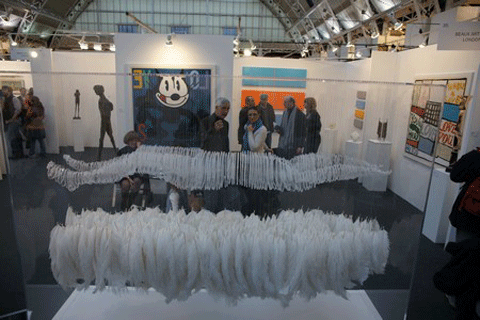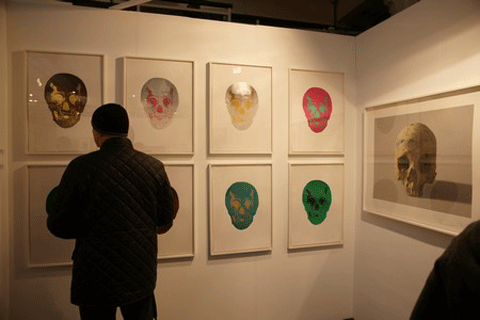Illustration by Rachel Lewis
I live in a state of perpetual disappointment that I was born in Hounslow in 1986, information pills see and not New York in 1943. In my dream life, I would be sitting in New York culture hotspots; watching The Velvet Underground one night, Ginsberg the next and have a general sense of anticipation about the evolution of the cultural revolution, which took place in small multifaceted venues mostly situated within Greenwich Village. Up until recently my ambitions to sit in such establishments, smoking cigarettes and experiencing ‘happenings’ looked as if they would continue to go by unactualised. That was until I stumbled across The Book Club, located in Leonard Street just off Old Street. The smoking is still out (damn you Patricia Hewitt, you wretched dream crushing hag) but the combination ‘drinking and thinking’ as The Book Club have put it, has finally been realised this side of the Nixon administration and the Atlantic. From the stylish exposed brickwork to the Ping Pong table, The Book Club manages to pull off the feat of being both effortlessly cool but without any trace of pretension. For those who want to experience a great night out without either running into a pack of slobbering drunken suits or the juxtaposing hipsters with their castrating drain pipes, The Book Club is the perfect inclusive venue for the patron who wishes to have a side order of intellectual stimulation with their excursions. As a journalist, I often worry about being a sop about things I really enjoy. If I’m nice about everything then I will never grab Walter Cronkite’s ghost by the balls and dismantle society as we know it, which is part of my vague and possibly ill-conceived master plan. But, once again, I am foiled by my own enthusiasm for how novel The Book Club is within a sea of mediocre venues and then once again by how lovely both of my interviewee’s are. It’s a nice thing when you find out that really awesome people run a really awesome venue. And there goes my future Pulitzer. Damn you, sentimental heart, damn you. Whatever your interest; be it life drawing, yoga classes, speed dating, Science lectures or film, The Book Club probably has something within it’s itinerary for you. Mightily impressed by all this venue represents, I sit down with the brains behind the operation, Liat Chen- the art producer and Heather Lawton – the creative director to talk about how The Book Club came into being.
I’d like to start by finding out how you conceptualised the idea of The Book Club: Heather: It was literally that I had come back from a trip in New York and I saw how different things were there, you could go to a café in the daytime and have a sandwich and go back in the evening and the lights are down, a DJ is playing and things are really kicking off. The venue hasn’t changed in anyway, it’s just finding a venue that can go through the different phases that you could go personally go through in the day; having coffee, having lunch, then partying in the evening. In the past, people have said that it couldn’t be done in one venue but I knew it could, and I think that’s what people want. You don’t necessarily want to bar hop all night, you just want to be somewhere and relax. This venue was originally a fine dining restaurant and then the recession hit the area. The corporate cards dried up, and there was no need for that type of restaurant in this area. So I had the idea that we could make a venue which brought people together who had similar interests, which is where the name The Book Club came along; somewhere that was quite inclusive and more than somewhere you go to drink. People want more now, with the recession, people want more from a night out than splashing the cash and getting wasted. They want to experience new events and meet likeminded people.
In terms of bringing on board the artists, how did that come about? Did you have a preconceived idea of what sort of artists and nights you wanted to host or did that come along later? Liat: For me it was quite clear, as I was coming from an area that specialised in subculture, which was when I was working for PYMCA for five years. PYMCA is a global research based company, which collects and archives youth culture imagery from all over the world and documents fashion, lifestyles, music and subculture movements dating back to the 50s. So I have been and continue to be inspired by them. I’m very passionate about these areas and that inspired the initial exhibitions we had. Dean Chalkley was the perfect match for those interests, whose exhibition is on currently, but in the future I’m interested in taking a different direction; currently I’m very interested in Pop Art.
The Book Club is very experimental in what you’ve chosen to do, it’s not just standard art, you have a whole range of activities. They all have an alternative appeal to those interested in subculture, but they are quite diverse. How did that work out? Heather: We’re always very open about the art that’s one the wall’s, the DJ’s that play and the promoters we bring on board. We wanted to be unconventional. London, let alone Shoreditch, is saturated with DJ’s banging out the same old thing every weekend. If you look at our weekend listings, there’s very unconventional things going on; like Swap-A-Rama Razzmatazz which is a swap night, you come along in whatever you’re wearing and be willing to give it all away in exchange for a completely new outfit at the end of the evening. We also have things like the Electro Swing night – it’s trying to bring different things into the area as Shoreditch got so rinsed with minimal techno nights and the area seemed to die a little bit, so we wanted to bring it back, and it worked. We have crazy queues every weekend now and it’s fun. Not everything has to be so serious.
Liat: For me, it’s not just about the art; it’s also about whom you’re working with. I want to work with people who have a really strong vision and…I guess a beautiful soul for lack of better words. I want to learn about what I’m doing, and create something really worthwhile. I don’t just want to put images on the wall; I want to bring the right people – from the creators to the audience – together. I want to make the space inviting and fresh. For the workshops, it was completely new to me. The life drawing is really popular. For something like that in most places you have to pay for a full course and it takes place in a sterile environment but here you can pay weekly and drink a glass of wine at the same time. Also the Science night which is a really interesting lecture. The lecturer invited all of us to Dover to search for crystals last time, so the venue is really open for every type of person with a wide range of interests, we’re not just a club or a bar, and there is everything here.
 Illustration by Luke James
Illustration by Luke James
Is there any direction that you haven’t explored yet that you would like to try? Liat: Well I’m moving on more from subculture to Pop Art. For the next exhibition the whole space will change. It’s been black and white here for some time, and next we’re going to explode with different colours. The next show is City of Abacus, which will be done by the singer V V Brown and illustrator David Allain. It’s a graphic novel that will be released at the end of the year. After that we have the exhibition ‘The Nancyboy Decade’, which is the artwork of Nancyboy: very bright, very vibrant.
How have you found combining a bar and a gallery in one space? Liat: It was quite a shock for me, who was used to working in a gallery. It was the same theme, building a beautiful space and bringing work together cohesively. But I found that after the private view, not many people would come. Here it is the opposite; the amount of recognition that the artist receives is unbelievable. The audience is completely diverse, from young kids to families to the elderly; the work is exposed to a wide demographic. But when I walk by on Friday night and see the place so packed, I have to close my eyes! But the art is always fine; people are very respectful to the work.
Heather: Sometimes people who are going out for a drink here don’t know that they’re also going into a gallery, so they get a lot more than a standard night out.
There’s a great community feel here, it feels so relaxed and with a great energy that feels so inclusive. How did you foster that atmosphere? Heather: You can’t put your finger on it. We had a clear concept, but we targeted creative people. People are into similar things in these circles, so it works when you bring them together.
Liat: Well first of all, you have to put the right people together from the grass roots. Heather and I work exceptionally well together, supporting each and stimulating ideas.
Heather: Also we all really believe in what we’re doing. We know where we want to go out, so we built a place that we would want to come to, and that our friends would want to come to.
Liat: The people who come, and the people behind the scenes all believe in what we’re doing. We believe in the art, the music, and the atmosphere. If I feel the right energy, the right intuition, then I go for it. I have to have passion and belief in my projects.
Heather: We could just open somewhere and sit back thinking the work is all done but we don’t. Every day we sit down, and analysing every aspect of what’s going on. Did the DJ play the right songs? Was the tutor at a workshop giving a good class? It’s not sitting back and allowing things to happen, we continue to helm the direction that we want The Book Club to follow.
Liat: We aren’t trying to be edgy, we aren’t trying to be cool, we’re being authentic to ourselves and people respond well to it.
Heather: All of our staff have an interest in something we’re doing here, either art, music or film. A lot of them are in art school or fashion school. We don’t care if you’re a fashionista or anything like that, but we want our staff to be interested in what it is that we’re doing. Some of the bar stuff are interns, they help with the posters. We’re a community within ourselves, and that atmosphere spreads through the venue.
Next Thursday the 15th The Book Club will be throwing a party to celebrate Dean Chalkley’s exhibition, which will feature live music, dancing and another opportunity to absorb the exhibition. For further information on upcoming events, please check The Book Club’s Website and the listings section at Amelia’s Magazine.
Categories ,60s, ,art, ,City of Abacus, ,david allain, ,Dean Chalkley, ,exhibitions, ,galleries, ,ginsberg, ,heather lawton, ,liat chen, ,nancyboy, ,nights out, ,PYMCA, ,subculture, ,swap shop, ,The Book Club, ,the new faces, ,The Velvet Underground, ,venues, ,visual music, ,vv brown, ,youth
Similar Posts:
- An interview with McBess about Big Mother
- Head Down It’s Sure To Be A Eccentric Night!
- Girls Day Out: The Paper Eater’s exhibition at Selfridges
- Art Listings
- Space to Draw












